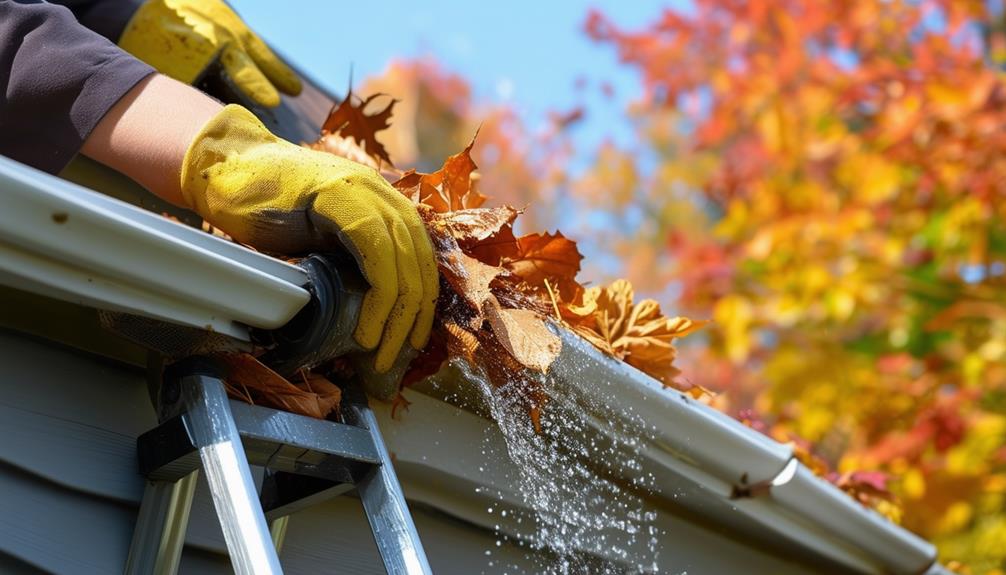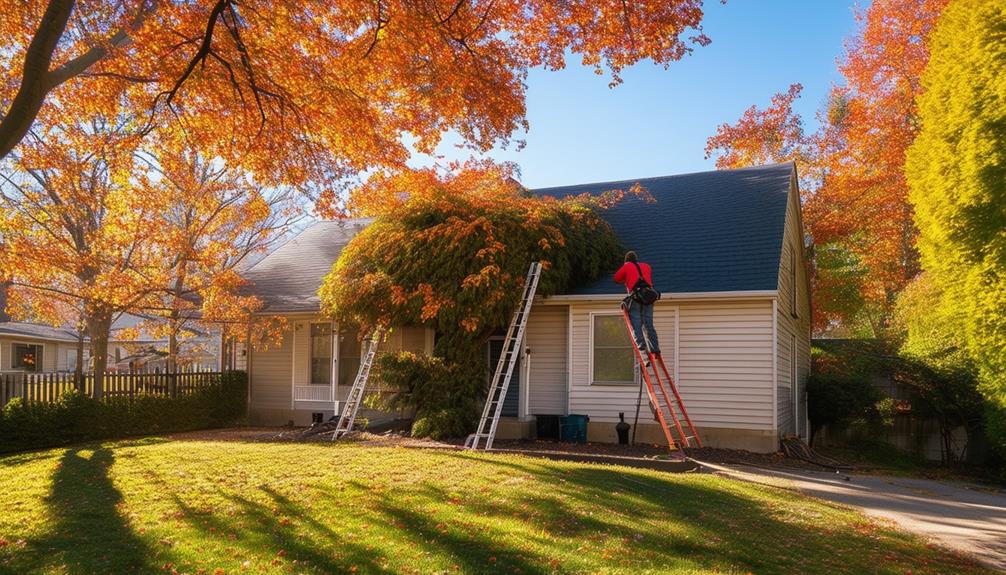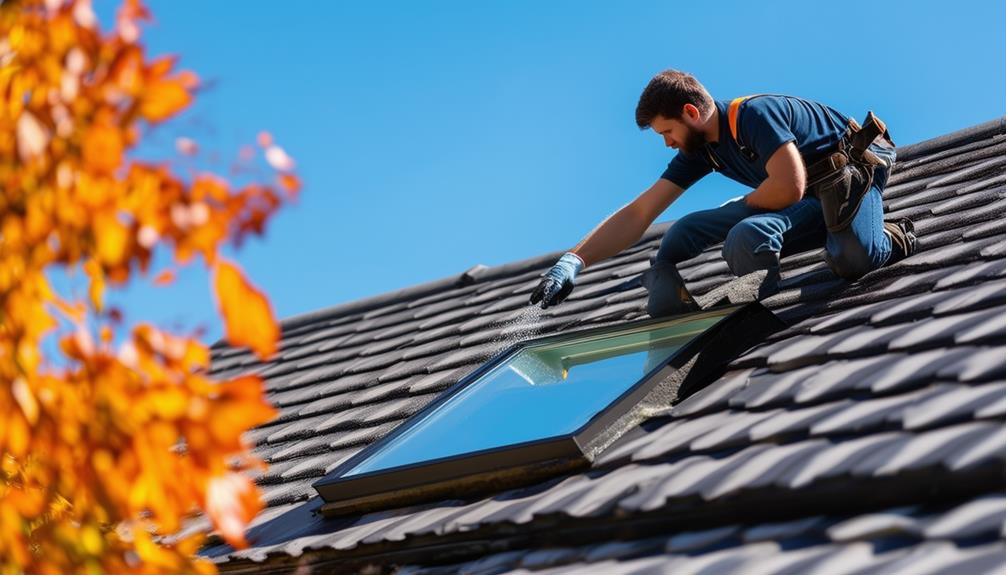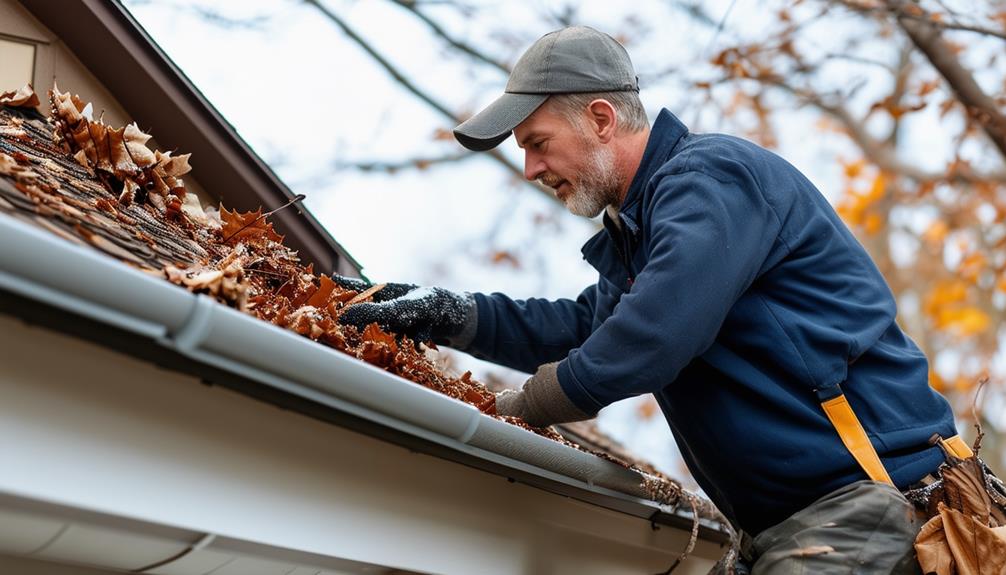Make sure your roof is ready for fall by clearing gutters and downspouts to prevent water damage. Inspect shingles for wear and tear, focusing on loose or shifted ones. Trim overhanging branches safely to avoid roof damage. Regularly check for leaks and water damage in flashing, shingles, and gutters. Clean and inspect skylights to prevent leaks or discoloration. If you want to protect your roof's longevity, it's important to follow a thorough maintenance checklist.
Clear Gutters and Downspouts

To prevent water damage and ensure proper drainage, regularly clear gutters and downspouts of debris such as leaves and twigs. This maintenance task is vital in ensuring that rainwater flows freely off your roof and away from your home's foundation. As part of your seasonal cleaning routine, inspect your gutters for any blockages and remove any built-up debris. Consider installing gutter guards to help prevent debris from accumulating and clogging the gutters in the future. Additionally, check that your downspout extensions are directing water at least 5 to 10 feet away from your home to prevent pooling near the foundation, which could lead to water seepage issues. Proper drainage is essential for the longevity of your roof and the structural integrity of your home. By taking the time to clear your gutters and downspouts regularly, you can avoid costly water damage repairs in the future.
Inspect Roof Shingles
Regularly inspecting your roof shingles is an essential part of maintaining the integrity and longevity of your roof structure. Start by visually examining the shingles for signs of wear and tear such as curling, cracking, or missing pieces. Shingle replacement and maintenance are vital to prevent water leaks and structural damage. Different roof shingle materials have varying lifespans; for instance, asphalt shingles typically last 15-30 years, while metal shingles can endure up to 50 years. During your inspection, pay attention to any areas where the shingles may be loose or have shifted out of place, as these can indicate underlying issues. Look for granules from asphalt shingles in the gutters, as excessive granule loss can signal the need for replacement. If you notice any damaged shingles or areas of concern, it's best to address them promptly to avoid more extensive damage and costly repairs in the future. Regular inspections can help you catch problems early and prolong the life of your roof.
Trim Overhanging Branches

Inspecting and trimming overhanging branches around your property is an essential step in maintaining the health and safety of your roof. Overgrown branches can cause damage to your roof during harsh weather conditions and even pose a risk of falling onto your property. Here are key points to contemplate when addressing overhanging branches:
- Tree Pruning: Regularly prune trees near your property to prevent branches from touching or hanging over your roof.
- Safety Precautions: Prioritize safety by using appropriate tools, wearing protective gear, and ensuring stable footing when trimming branches.
- Branch Trimming: Evaluate whether you can safely trim branches yourself or if it's best to hire a professional tree service.
- DIY vs. Professional: While DIY trimming can save money, professional arborists have the expertise to trim branches effectively and safely, reducing the risk of accidents.
Check for Leaks and Water Damage
Evaluate your roof for leaks and water damage by conducting a thorough inspection of key areas prone to issues such as flashing, shingles, and gutters. Start by examining the flashing around chimneys, vents, and skylights. Look for any signs of damage, deterioration, or gaps that could allow water to seep through. Inspect the shingles for any cracks, missing pieces, or curling edges that may indicate potential leaks. Additionally, check the gutters for clogs or damage that could prevent proper drainage and lead to water pooling on the roof.
Water damage can result from even minor issues on the roof, making regular roof maintenance important to prevent costly repairs down the line. Addressing leaks promptly is crucial to avoid structural damage and mold growth within your home. By staying vigilant and proactive in your roof maintenance efforts, you can safeguard the longevity and integrity of your roof while protecting your property from water damage.
Clean and Inspect Skylights

Guarantee meticulous cleanliness and inspection of skylights to maintain their peak functionality and prevent potential issues. Skylights are a beautiful addition to any home, but they require regular maintenance to make sure they continue to brighten your space without causing problems. Here are some essential tips to keep your skylights in top condition:
- Regular Cleaning: Use a gentle cleanser and a soft cloth to remove dirt and debris from both the interior and exterior of the skylight. This will prevent buildup that can lead to leaks or discoloration.
- Check Seals and Caulking: Inspect the seals and caulking around the skylight for any cracks or gaps. These can allow water to seep in, leading to potential water damage.
- Skylight Replacement: If you notice significant damage or aging on your skylight, consider investing in a replacement to maintain efficiency and prevent leaks.
- Proper Ventilation: Make sure that your skylight has proper ventilation to prevent condensation buildup and mold growth.
Schedule a Professional Inspection
When it comes to maintaining your roof, scheduling a professional inspection is vital to guarantee the structural integrity of your home. An expert inspection can catch potential issues early, saving you from costly repairs down the line. By being proactive and investing in regular maintenance, you can prolong the lifespan of your roof and protect your property from damage.
Expert Inspection Importance
Consider scheduling a professional inspection to guarantee a thorough assessment of your roof's condition and maintenance needs. A roofing expert's advice can provide valuable insights into the safety and maintenance requirements of your roof. Here are four reasons why an expert inspection is important:
- Safety First: A professional inspection ensures that any potential safety hazards on your roof are identified and addressed promptly.
- Expertise Matters: Roofing experts possess the knowledge and experience to spot even minor issues that untrained eyes might miss.
- Preventative Maintenance: By detecting problems early, you can prevent costly repairs down the line, saving you time and money.
- Peace of Mind: Knowing that your roof has been thoroughly inspected by a professional can give you peace of mind and assurance that your home is well-protected.
Investing in a professional inspection now can save you from more significant issues in the future.
Proactive Maintenance Benefits
Scheduling a professional inspection for proactive maintenance benefits is crucial for guaranteeing the longevity and safety of your roof. By taking preventive measures through regular inspections, you can identify and address potential issues before they escalate into costly repairs or replacements. Professional roof inspections allow trained experts to assess the condition of your roof, identifying weak spots, leaks, or damage that may not be visible to the untrained eye.
Investing in proactive maintenance offers long-term benefits that extend the life of your roof. Detecting and repairing small problems early on can prevent them from worsening over time, ultimately saving you money in the long run. Additionally, a well-maintained roof enhances the overall value and curb appeal of your property. Regular inspections also ensure that your roof is in compliance with safety regulations, providing you with peace of mind knowing that your home is protected from potential hazards. Prioritizing proactive maintenance through professional inspections is a wise decision for the health and durability of your roof.
Prepare for Winter Weather

As winter approaches, it's important to make sure your roof is prepared to withstand the harsh weather conditions ahead. Winterizing your roof involves checking for any existing leaks or potential weak spots that could lead to water damage during snow and ice accumulation. Taking the time now to address these issues can help prevent costly repairs and maintain the integrity of your roof throughout the winter months.
Winterizing Your Roof
To guarantee your roof is prepared for the upcoming winter weather, inspect the shingles, flashing, and gutters for any signs of damage or wear. Proper maintenance is essential to prevent issues during the colder months. Here are some essential steps to winterize your roof effectively:
- Check Roof Insulation: Make sure your roof has adequate insulation to help regulate the temperature in your home and prevent ice dams caused by heat escaping through the roof.
- Inspect for Snow Buildup: Clear any debris that could obstruct proper drainage and lead to snow buildup, which adds weight and stress to your roof structure.
- Trim Overhanging Branches: Prune trees near your roof to prevent heavy snow or ice-laden branches from falling and damaging the roof.
- Secure Loose Shingles: Secure any loose shingles to prevent them from becoming dislodged during winter storms, which can lead to leaks and further damage.
Taking these proactive measures will help ensure your roof is ready to withstand the challenges of the winter season.
Checking for Leaks
Inspecting for leaks is an essential step in preparing your roof for winter weather, ensuring your home remains protected from potential water damage and costly repairs. Begin the leak detection process by examining your attic for any signs of water stains, mold, or musty odors. Check the ceilings and walls for discoloration or bubbling paint, as these could indicate an active leak. In case of visible damage, it is vital to address it promptly to prevent further issues.
When it comes to repair options, consider consulting a professional roofer to assess the extent of the damage. Depending on the severity, repair techniques may range from simple patching to more extensive fixes. Additionally, implementing roof waterproofing techniques and prevention strategies can help mitigate future leaks. These may include applying sealants, installing a waterproof membrane, or ensuring proper roof ventilation.
Frequently Asked Questions
How Do I Know if My Roof Needs Repairs Beyond Cleaning?
To determine if your roof needs repairs beyond cleaning, look for signs like missing shingles, water stains on ceilings, or sagging areas. These issues may indicate the need for roof replacement. Avoid common mistakes such as neglecting regular inspections or using improper materials for repairs. If you suspect serious damage, consult a professional roofer for a thorough assessment to guarantee your roof's longevity and safety.
Can I Prune Overhanging Branches Myself or Hire a Professional?
If you're considering pruning overhanging branches, assess the task's complexity and your comfort level with heights. For DIY pruning, guarantee safety precautions like using proper tools and protective gear. If the job seems challenging or risky, consider hiring a professional for tree trimming. Professionals have the expertise to handle difficult situations safely. Make the decision based on your confidence in handling the task and the potential risks involved.
What Are the Signs of a Roof Leak That I Should Look Out For?
To detect a roof leak, keep an eye out for water stains on your ceiling or walls. These can indicate water seepage. Additionally, be vigilant for any signs of mold growth, as dampness from a leak can create a breeding ground for mold. By promptly addressing these visual cues, you can prevent further damage to your roof and home. Regular inspections can help catch leaks early, minimizing repair costs in the long run.
Are There Specific Maintenance Tasks for Different Types of Skylights?
When it comes to skylights, proper maintenance is essential. Different types of skylights require specific care. Skylight ventilation is important for preventing moisture buildup and mold growth. Regularly checking for condensation issues can help you address any potential leaks early on. Keep the skylight clean and free of debris to guarantee top performance. Regular inspections and maintenance will help extend the lifespan of your skylight and prevent costly repairs down the road.
How Often Should I Schedule a Professional Roof Inspection?
You should schedule a professional roof inspection at least once a year to safeguard your roof's integrity. While you can perform some maintenance tasks yourself, a professional inspection is essential for detecting hidden issues early on. Regular inspections help prevent costly repairs by addressing problems promptly. Trusting a professional ensures a thorough evaluation of your roof's condition and guarantees peace of mind knowing your home is well-maintained.
Conclusion
Now that you've completed your fall roof maintenance checklist, you can rest easy knowing your home is prepared for the upcoming winter months. Remember, maintaining your roof is vital for protecting your investment and ensuring the safety of your family. Just like Mary in Chicago, who discovered a small leak during her fall roof inspection and was able to address it before it turned into a major issue. Stay proactive and stay safe! By taking care of any necessary repairs now, you can save yourself from costly damage and stress down the road. As the seasons change, don’t forget to follow up with some essential winter roof maintenance tips to keep your home safeguarded against snow, ice, and freezing temperatures. A little preparation goes a long way in ensuring your roof remains in excellent condition all year round.




